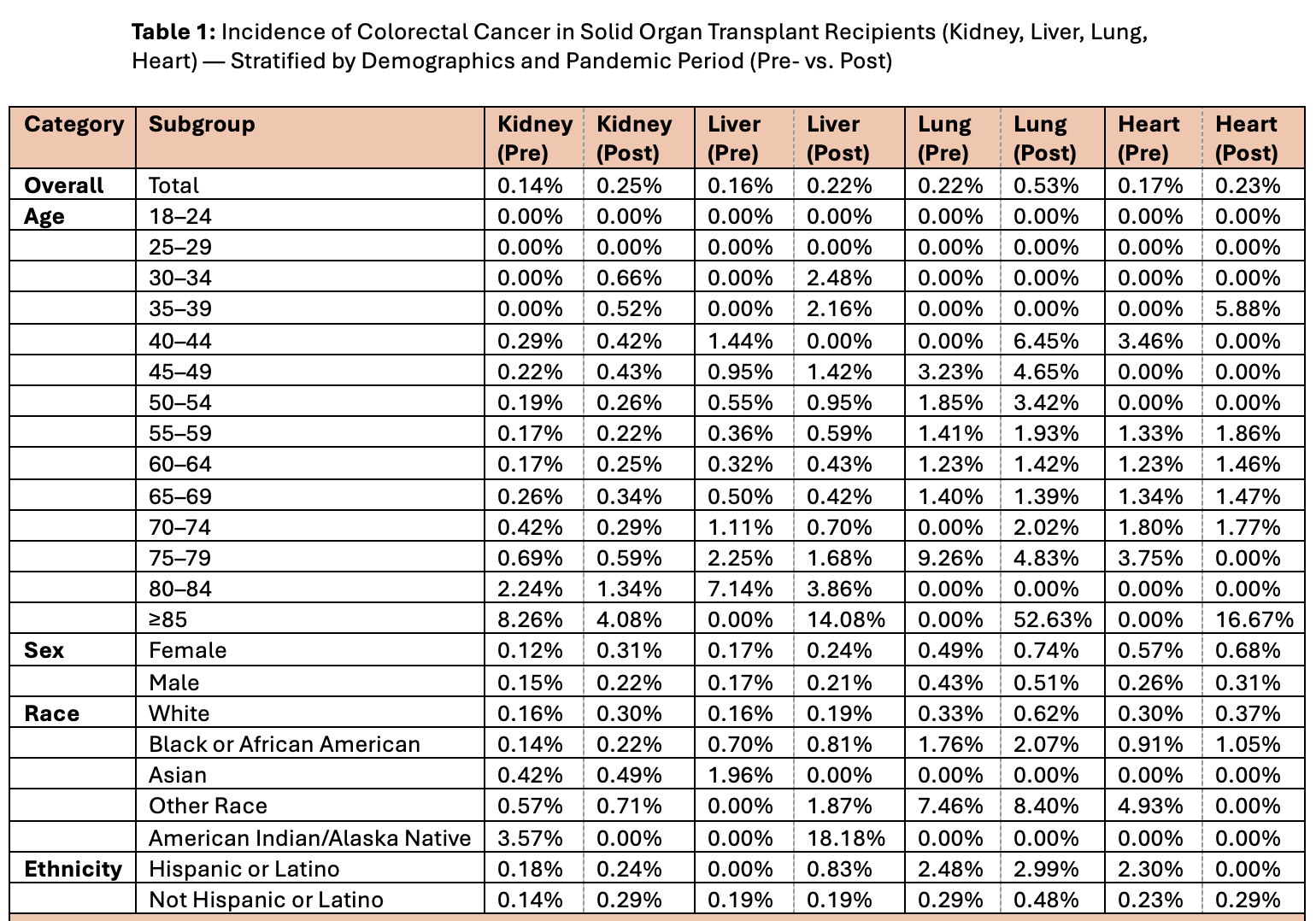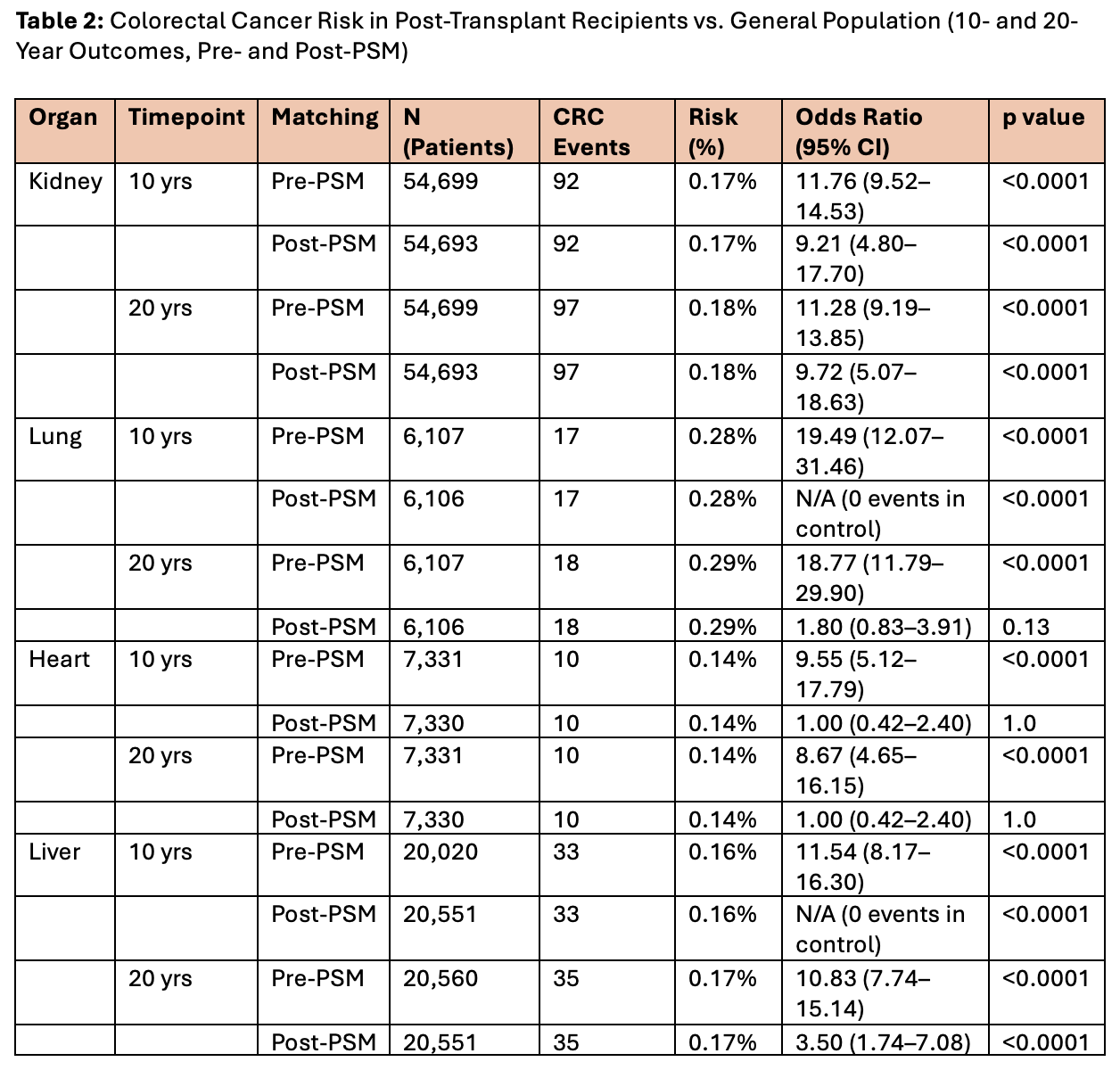Monday Poster Session
Category: Colorectal Cancer Prevention
P2642 - Should We Screen Sooner? Elevated Colorectal Cancer Incidence in Solid Organ Transplant Recipients in the United States Before and After the COVID-19 Pandemic
Monday, October 27, 2025
10:30 AM - 4:00 PM PDT
Location: Exhibit Hall
.jpg)
Alexander Malik, MD
Case Western Reserve University / MetroHealth
Cleveland, OH
Presenting Author(s)
Award: ACG Presidential Poster Award
Alexander Malik, MD1, Thai Hau Koo, MD2, Mohammed Sheriff, MD3, Adrian S. Lindsey, MD1
1Case Western Reserve University / MetroHealth, Cleveland, OH; 2University of Sciences Malaysia Specialist Hospital, Kelantan, Kelantan, Malaysia; 3Louis Stokes Cleveland VA Medical Center, Cleveland, OH
Introduction: Solid organ transplant recipients have an elevated risk for malignancy due to long-term immunosuppression; however, the risk of colorectal cancer (CRC) in this population is under-characterized. We aimed to evaluate the incidence of CRC in kidney, liver, lung, and heart transplant recipients, focusing on trends before and after the COVID-19 pandemic.
Methods: We conducted a retrospective cohort study using de-identified patient data from the TriNetX dataset. Adults (≥18 years) with a documented solid organ transplant (kidney, liver, lung, or heart) and a continuous record of immunosuppressive therapy for ≥6 months post-transplantation were included. Each transplant cohort was compared with a general population comparator group with no history of solid organ transplantation and no exposure to immunosuppressive therapy. Patients with a prior diagnosis of CRC at baseline were excluded from all cohorts. Propensity score matching (PSM) was conducted to balance for demographics and confounders. The primary outcome was the incidence of CRC at 10-year and 20-year follow-up intervals following the transplant index date. Secondary analyses assessed the incidence proportions pre-pandemic vs. post-pandemic.
Results: Across over 250,000 transplant recipients, CRC incidence was significantly higher in all organ transplant cohorts than in the general population. Post-PSM odds ratios (ORs) for CRC at 10 years were: kidney 1.26 (95% CI 1.15–1.38), liver 1.31 (1.17–1.47), lung 1.39 (1.16–1.67), and heart 1.31 (1.08–1.59), all p< 0.01. At 20 years, post-PSM CRC incidence remained elevated in all transplant groups (p< 0.05). Pre- and post-pandemic incidence proportions increased across all subgroups, most notably among older adults (≥70 years) and Hispanic individuals. Lung and heart transplant recipients showed a particularly high post-pandemic CRC incidence among the elderly (e.g., lung ≥85 years: 52.63%). Overall, CRC incidence was higher in males versus females and non-Hispanic versus Hispanic patients, although both trends narrowed post-pandemic.
Discussion: CRC incidence was consistently and significantly elevated across kidney, liver, lung, and heart recipients, with an increased risk persisting over 20 years of follow-up. These findings highlight the potential need to revisit CRC screening strategies in transplant recipients, particularly in older adults and in racially or ethnically diverse populations.

Figure: Table 1: Incidence of Colorectal Cancer in Solid Organ Transplant Recipients (Kidney, Liver, Lung, Heart) — Stratified by Demographics and Pandemic Period (Pre- vs. Post)

Figure: Table 2: Colorectal Cancer Risk in Post-Transplant Recipients vs. General Population (10- and 20-Year Outcomes, Pre- and Post-PSM)
Disclosures:
Alexander Malik indicated no relevant financial relationships.
Thai Hau Koo indicated no relevant financial relationships.
Mohammed Sheriff indicated no relevant financial relationships.
Adrian Lindsey indicated no relevant financial relationships.
Alexander Malik, MD1, Thai Hau Koo, MD2, Mohammed Sheriff, MD3, Adrian S. Lindsey, MD1. P2642 - Should We Screen Sooner? Elevated Colorectal Cancer Incidence in Solid Organ Transplant Recipients in the United States Before and After the COVID-19 Pandemic, ACG 2025 Annual Scientific Meeting Abstracts. Phoenix, AZ: American College of Gastroenterology.
Alexander Malik, MD1, Thai Hau Koo, MD2, Mohammed Sheriff, MD3, Adrian S. Lindsey, MD1
1Case Western Reserve University / MetroHealth, Cleveland, OH; 2University of Sciences Malaysia Specialist Hospital, Kelantan, Kelantan, Malaysia; 3Louis Stokes Cleveland VA Medical Center, Cleveland, OH
Introduction: Solid organ transplant recipients have an elevated risk for malignancy due to long-term immunosuppression; however, the risk of colorectal cancer (CRC) in this population is under-characterized. We aimed to evaluate the incidence of CRC in kidney, liver, lung, and heart transplant recipients, focusing on trends before and after the COVID-19 pandemic.
Methods: We conducted a retrospective cohort study using de-identified patient data from the TriNetX dataset. Adults (≥18 years) with a documented solid organ transplant (kidney, liver, lung, or heart) and a continuous record of immunosuppressive therapy for ≥6 months post-transplantation were included. Each transplant cohort was compared with a general population comparator group with no history of solid organ transplantation and no exposure to immunosuppressive therapy. Patients with a prior diagnosis of CRC at baseline were excluded from all cohorts. Propensity score matching (PSM) was conducted to balance for demographics and confounders. The primary outcome was the incidence of CRC at 10-year and 20-year follow-up intervals following the transplant index date. Secondary analyses assessed the incidence proportions pre-pandemic vs. post-pandemic.
Results: Across over 250,000 transplant recipients, CRC incidence was significantly higher in all organ transplant cohorts than in the general population. Post-PSM odds ratios (ORs) for CRC at 10 years were: kidney 1.26 (95% CI 1.15–1.38), liver 1.31 (1.17–1.47), lung 1.39 (1.16–1.67), and heart 1.31 (1.08–1.59), all p< 0.01. At 20 years, post-PSM CRC incidence remained elevated in all transplant groups (p< 0.05). Pre- and post-pandemic incidence proportions increased across all subgroups, most notably among older adults (≥70 years) and Hispanic individuals. Lung and heart transplant recipients showed a particularly high post-pandemic CRC incidence among the elderly (e.g., lung ≥85 years: 52.63%). Overall, CRC incidence was higher in males versus females and non-Hispanic versus Hispanic patients, although both trends narrowed post-pandemic.
Discussion: CRC incidence was consistently and significantly elevated across kidney, liver, lung, and heart recipients, with an increased risk persisting over 20 years of follow-up. These findings highlight the potential need to revisit CRC screening strategies in transplant recipients, particularly in older adults and in racially or ethnically diverse populations.

Figure: Table 1: Incidence of Colorectal Cancer in Solid Organ Transplant Recipients (Kidney, Liver, Lung, Heart) — Stratified by Demographics and Pandemic Period (Pre- vs. Post)

Figure: Table 2: Colorectal Cancer Risk in Post-Transplant Recipients vs. General Population (10- and 20-Year Outcomes, Pre- and Post-PSM)
Disclosures:
Alexander Malik indicated no relevant financial relationships.
Thai Hau Koo indicated no relevant financial relationships.
Mohammed Sheriff indicated no relevant financial relationships.
Adrian Lindsey indicated no relevant financial relationships.
Alexander Malik, MD1, Thai Hau Koo, MD2, Mohammed Sheriff, MD3, Adrian S. Lindsey, MD1. P2642 - Should We Screen Sooner? Elevated Colorectal Cancer Incidence in Solid Organ Transplant Recipients in the United States Before and After the COVID-19 Pandemic, ACG 2025 Annual Scientific Meeting Abstracts. Phoenix, AZ: American College of Gastroenterology.

